Drag Queen Gamers Are Proof That Gaming Isn’t Just for ‘Tomboys’

ILLUSTRATORS: SARAH MAIDEN AND EMILY LUNDIN,BIQTCH PUDDIN'/JACOB RITTS/DEERE/DRAG TRASHLY/ERIKA KLASH HELLOGIGGLES,
Female gamers are often under-recognized and discredited within their male-driven industry, but Female gamers are often under-recognized and discredited within their male-driven industry, despite making up nearly 41 percent of all gamers in the United States. That's why this month, we're highlighting the women who are changing the gaming industry with The Game Plan. Here, we're diving into the world of drag queen gamers, the surprising ways gaming can affect your mental health, and so much more. Play on.
Drag in its simplest, most modern form is an outlet for self-expression. The long history of drag dates back to the 19th century, but drag queens and kings growing up in the 1980s and 1990s didn't have 13 seasons of RuPaul's Drag Race to lean on for representation. There was, however, plenty of inspiration coming from the video game industry.
The release of the Nintendo Entertainment System in 1985 started a domino effect of console wars and video gaming content that quickly took over mainstream pop culture, with many of the games translating into the film industry. For some gamers who felt otherized in real life, this endless array of characters and content provided an outlet for them to escape into their own world by envisioning themselves as the characters they saw onscreen.
Even today, the LGBTQIA+ community represents a large portion of game players, many of whom look to simulation games as a means to escape from the outside world and connect with one another. This community is also 54% more likely to own gaming consoles, as well as to spend more money on video gaming content each month compared to non-LGBTQIA+ consumers. So, it's no surprise that as so many people turned to video gaming as a means to escape during quarantine last year, the drag queen gamer community turned to the streaming platform Twitch as a means to stay connected with their fans, raise money for charities, and help with their own mental health.
Within the first month of the pandemic, Twitch engagement more than doubled, with hours spent on the platform increasing from 13 million to 31 million in March of 2020. Twitch drag events like Digital Drag Show, Reclaiming My Time, and Stream Queens: Empowered joined the ranks of more mainstream drag content like RuPaul's Drag Race, The Boulet Brothers' Dragula, and We're Here with drag queens moving their audiences to streaming services due to the cancellation of in-person drag shows at bars. Digital Drag Show, for instance, hosted their first event to an audience of over 10,000 viewers with only a few days notice.
These days, drag culture is represented in gaming more than ever before. We connected with five drag queen gamers, who told us about their streaming experiences, where they'd like to see the gaming community make more space for fellow LGBTQIA+ content creators, and the drag beauty trends trending on Twitch.
Biqtch Puddin'
@biqtchpuddin | The Boulet Brothers' Dragula S2 Winner & Creator of Digital Drag Show
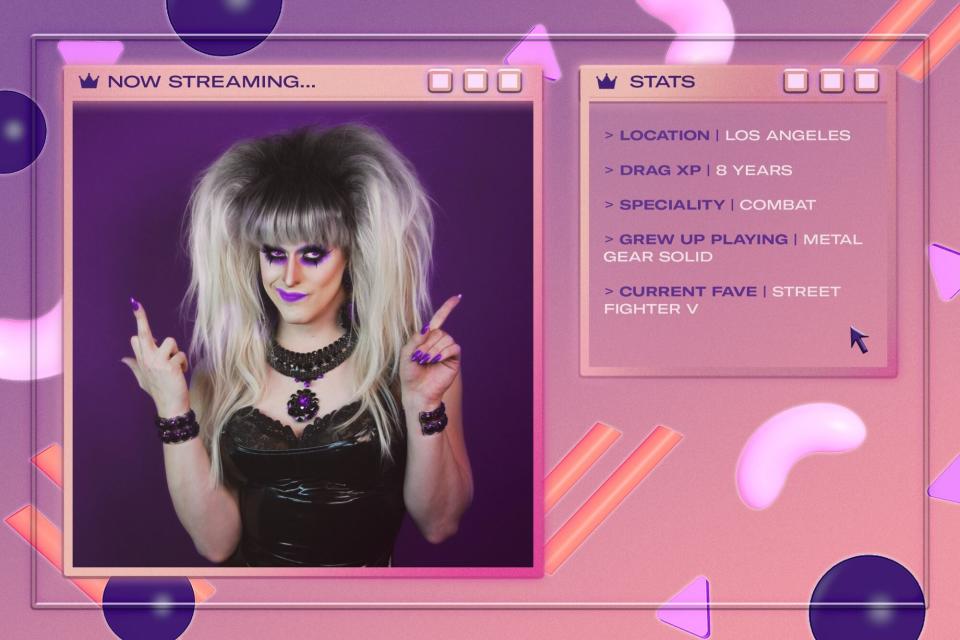
Illustrators: Sarah Maiden and Emily Lundin, Biqtch Puddin', HelloGiggles
Biqtch Puddin' (BP): After going on [The Boulet Brothers'] Dragula in 2017, I really wanted to move to Twitch because it's a huge part of my drag identity to take '90s video game vixens I played in Street Fighter and other games and combine that into my drag persona. I was like, "Oh, awesome. I finally get to do what I want!" and then my home was robbed. I couldn't afford to repurchase all of my video game equipment again, because I was a broke drag queen living in Skid Row without insurance.
So, after winning Dragula in 2018, I slowly started to purchase gaming equipment I needed over the next two years. Going into 2020, I was in a place where I needed to buy a few more things and then I was Gucci. That's when I started to stream sporadically and the pandemic hit. I was actually supposed to headline at the launch party for Final Fantasy 7. I was working with Playstation—which was dream come true level shit—and then it was cancelled. I was sad and frustrated and cussing everyone out saying, "What am I supposed to do now? Digital drag?" and my roommate, who is now a co-producer of Digital Drag Show [on Twitch] came out of her room and was like, "That sounds like a great idea."
We cast and announced the show on a Monday [in March of 2020] and by that Friday, we were performing on Twitch with over 10,000 viewers.
HG: What inspired you to incorporate video game characters into your drag persona?
BP: Growing up, I was always bullied. I would go home and play Yuna in Final Fantasy X or Sniper Wolf in Metal Gear Solid, and I would just imagine myself as these women in these video games. After seeing other drag queens perform and watching some of them combine their inspirations with their drag to make it more unique, I came to the realization that I'd never have to do anything ever again if I did that with my drag. So I took inspiration from the hot, badass women like Ivy from Soul Calibur, Nina from Tekken, and Cammy from Street Fighter, who kicked ass in the video games I played growing up and incorporated that into my drag.
HG: What are your thoughts on the intersectionality between drag and cosplay?
BP: Cosplay has always been happening, which is why cosplay and drag are basically the same thing in my opinion. I feel like a lot of cosplay comes from our nostalgia factor and whatever we really identified with growing up. For the generation of queens before me, I Love Lucy and Cher are a huge inspiration. So they incorporated those characters into their drag. The only thing that makes drag different is that there is more emphasis on exaggeration. A drag artist's approach to cosplay is to tease the wig of the costume and make it better than buying it off Amazon and putting it on as a hard front with some blush and saying "I'm Raven from Teen Titans!" It's got to be zhuzhed. That's the only real difference I can see between the two.
HG: As an Emmy-nominated makeup artist for EastSiders, what beauty trends would you like to see more of in the streaming community?
BP: I'd love to see more makeup [tutorials]! On Twitch, it's really rare to see drag queens sit down and do their makeup unless they're doing it for a livestream. They usually kind of rush that process before their stream. So, when you're on Twitch and you're streaming, you should just really get your hands dirty and have fun with your audience and be like, "Y'all want me to use this ugly ass purple?" And then you have to figure out how to make it work with your look.
I'd love to see more intensity and exaggeration, more neon pigments being used on the face. I'd also love to see prosthetics pop off. I think the kids now are going to get bored within a year or two, because they're really doing makeup and loving the beauty aspect of it. They are going to get to a point where they have mastered that skill and it's so pristine that now they are going to want to try the next step, which is changing your face with silicone. Not silicone as in injections, but, you know, brow covers or adding cool ridges to highlight their bone structure or to just change their face to be completely different from their natural look. I hope that's where it goes because the film industry now is so heavily reliant on CGI, and I feel like the best films are made with really great prosthetic work. So that's why I hope it happens because then maybe it will affect the industry as a whole and bring back that art.
Bob the Drag Queen
@OfficialBobTheDragQueen | RuPaul's Drag Race S8 Winner & Star of We're Here on HBO
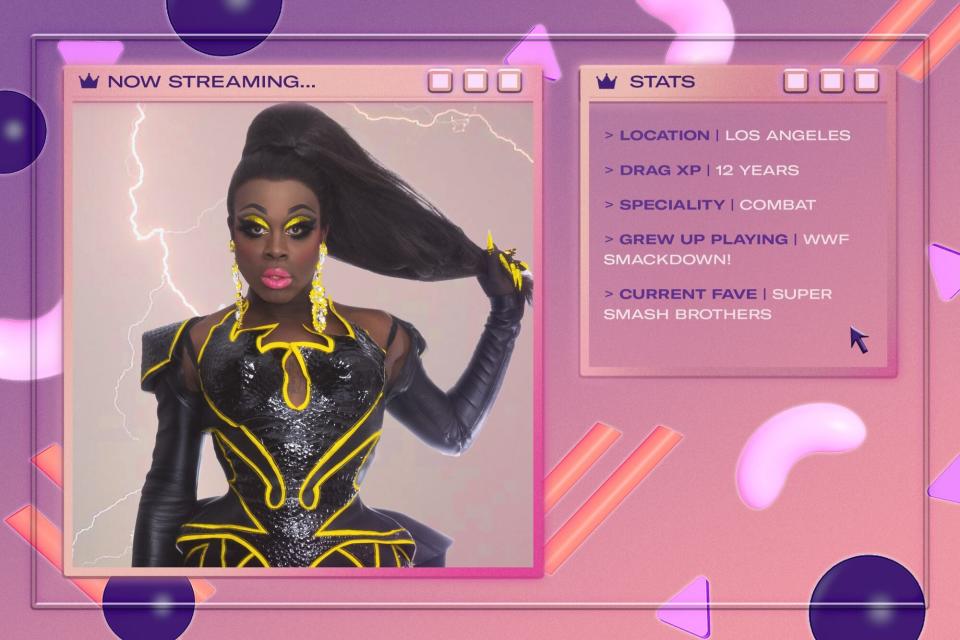
Illustrators: Sarah Maiden and Emily Lundin, Jacob Ritts, HelloGiggles
HelloGiggles (HG): Tell us about your history with gaming.
Bob the Drag Queen (BDG): Even though I was a really big gamer when I was younger, I kind of stopped playing video games for a while because when I was in college [in 2004] my Playstation 2 console was stolen from me. I never replaced it because gaming consoles are expensive. So, by the time I started to pick it up again, I was so behind on games. I ended up buying a Nintendo Switch, because it's a great console for traveling and then I found out how many [RuPaul's] Drag Race girls also play the Switch, so now we all play together.
HG: What kickstarted your move into streaming?
BDG: I was inspired by [Drag Queen star and gamer] Trixie Mattel, who was on Twitch raising money for charities. I needed to help raise money for Queer Black Excellence, which is a Pride event for Twin Cities. I was already playing Super Smash Brothers every day, either by myself or with other Drag Race girls, and I was like, "Maybe I can actually help them raise money by playing video games." Over the course of two weeks, we raised $10,000 for Queer Black Excellence.
HG: The gaming world hasn't always been a safe space for womxn or the queer community, thanks to male toxicity. What is being a part of the Twitch community like for you?
BDG: The gaming community has a very checkered past, in regards to how they treat people of color, women, and queer people across the board.
Drag today is not exclusively cis-masc. There are a lot of cis-women who do drag, trans women who do drag, and non-binary people, like myself, who do drag. For people entering this space, there is a strong community of like-minded people in the world who are just trying to uplift each other while playing some video games.
A lot of times for women and femme-presenting people, the internet can be a really mysognistic place. There are lots of women in the gaming community who capitalize on their sexiness and femininity and the male gaze. And honestly, to them I say: "Go off, sis. Get your coin." If they're going to be casting their male gaze, make them pay you for it.
HG: In regards to the relationship between drag and video game cosplay, what are your thoughts on critiques about drag outfits looking too "crafty" or "costumey"?
BDG: I find it so interesting considering that drag is dress up and dress up is costume. Some people just want to be Storm from X-Men. Some people want to be Shiva from Final Fantasy with all of the ponytails. Some people want to be like a film version of the Joker. Not everyone is trying to be on the cover of Vogue. I work with Domino Couture who designs all of my costumes for We're Here on HBO and he's a really brilliant cosplay artist and does some really phenomenal work.
HG: How do you see drag continuing to play a role in makeup and beauty trends? Any wild trends you think might pop up this year in streaming and TikTok feeds?
BDG: In the '90s, makeup was really heavy (think Tyra Banks and Naomi Campbell). In the early 2000s, it kind of toned down a little bit. Then by 2010, it was about the no-makeup look (with Cara Delevingne and the Kardashians/Jenners). Now it's like looping back around again where makeup looks are just bananas. So, I mean, who else is there to look to besides drag queens, burlesquers, and clowns for your makeup inspiration?
I think you're getting the opposite of wild in terms of hair, though: It's getting flatter. The flatness of the wigs takes me out of it because, while I don't want to be wearing huge hair, I'm rarely in a tiny little hair piece. Eyes, though, are getting sharper and sharper which is how I do my makeup. I love a sharp eye.
Deere
@Deere | Stream Queens Founder & 2021 LGBTQ Streamer of the Year
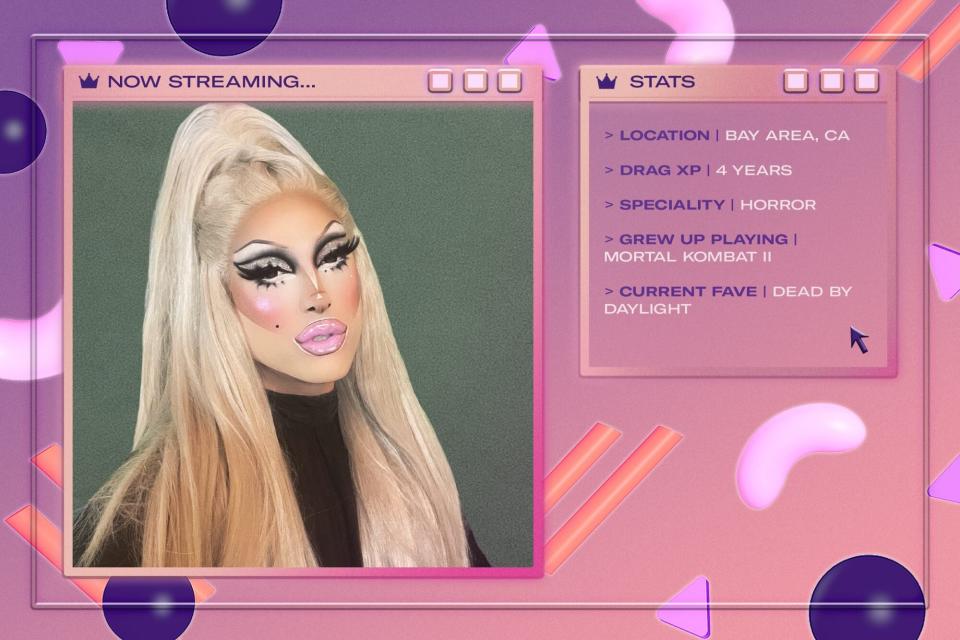
Illustrators: Sarah Maiden and Emily Lundin, Deere, HelloGiggles
HG: What inspired you to become a drag queen on Twitch?
Deere (D): I had wanted to be a drag queen for a very long time, and I was yearning for a way to express that aspect of my creativity in a way that merged my passions—gaming and makeup artistry. For as long as I can remember, I have loved exaggerated and distinct femininity showcased in media and games, particularly in the way that makeup as a concept is often used to evoke someone's personality. This led me to being a makeup artist as a teenager.
However, I got a bit more enjoyment from the freedom I had when I was putting makeup on myself instead of other people. That sense of personal freedom with makeup and styling led to me becoming a drag queen. So Twitch was a dream come true. I never thought I could play video games in drag full-time but here we are!
HG: How did you start Stream Queens (the all-drag troupe of content creators which includes kings, queens, characters, and creatures) on Twitch?
D: When I started streaming, the landscape of Twitch was way different than it is today. Only a handful of drag-focused channels existed and diversity was difficult to discover. As my channel started to close in on the Twitch Partnership Program requirements, I learned that Twitch partners are able to start teams (a way of unifying different channels together on one page). I decided to pursue a team that revolved around drag! It's amazing because it allows so many drag artists to collaborate and learn from each other [while playing video games].
HG: Drag within the gaming community allows for more of an amplified space for both drag and cosplay. What does this mean to you?
D: To me, drag is a very personal experience. I think anything and everything can be drag, but at its core, it's a costume that unlocks another side of yourself. I never understood the critique that something is "not drag" because it's a costume. Drag is literally a costume. It's an exaggeration based around celebrating the gender norms put on us by society, whether it is by amplifying it or subverting it. I believe cosplay can be drag and heavy makeup and costuming can be drag. The most important part is that the person wearing it identifies it as such. Because, to me, drag should be a proud celebration.
HG: What advice do you have for first-time gamer queens and gamer girls who may be intimidated to enter into the streaming space, and who do you look to as inspiration in the space?
D: For first-time streamers, especially those who are not the typical white, straight, young man, I say go for it! Representation and visibility matter and if you don't see yourself in the media, get out there and be the representation for others. We are at 70 channels on the [Stream Queens] team and the fact that these creators put themselves in drag day in and day out is like putting a target on their backs for hate. People just don't get what we do sometimes. But when these artists hold their heads high and are proud of their craft, it is the most inspiring thing in the world.
I believe that we represent something bigger than us as individuals just by existing in the first place... Everyone that utilizes the LGBTQIA+ tag on Twitch is my hero, because hateful users literally peruse that tag to find people to harass. However, I and many others still use the tag despite that, because it helps us to discover and support those that are like us. That is why I believe that it is important to create a trans tag on Twitch for trans individuals to have that same sense of support and visibility to each other.
HG: As a makeup artist/gamer-turned-drag queen, what makeup trends are you most excited about? Are there any trends you hope to see?
D: I love that the makeup industry and its trends are ever-evolving. When it comes to E-girl looks, I've loved seeing the overlined lips, heavy blush, drawn-on features like moles, freckles, and hearts. Makeup, to me, is exciting—especially when it starts to go into the dramatic and over-the-top. I love makeup that is apparent and leaves an emotional reaction.
I hope that we get a cool-toned trend someday! I have always personally preferred cool tones but a lot of people go for warm undertones all the time. I'd love to see a wider embrace of that color palette. It's time for cool tones to make a splash.
Drag Trashly
@dragtrashly | Original Stream Queens Member & Twitch Partner
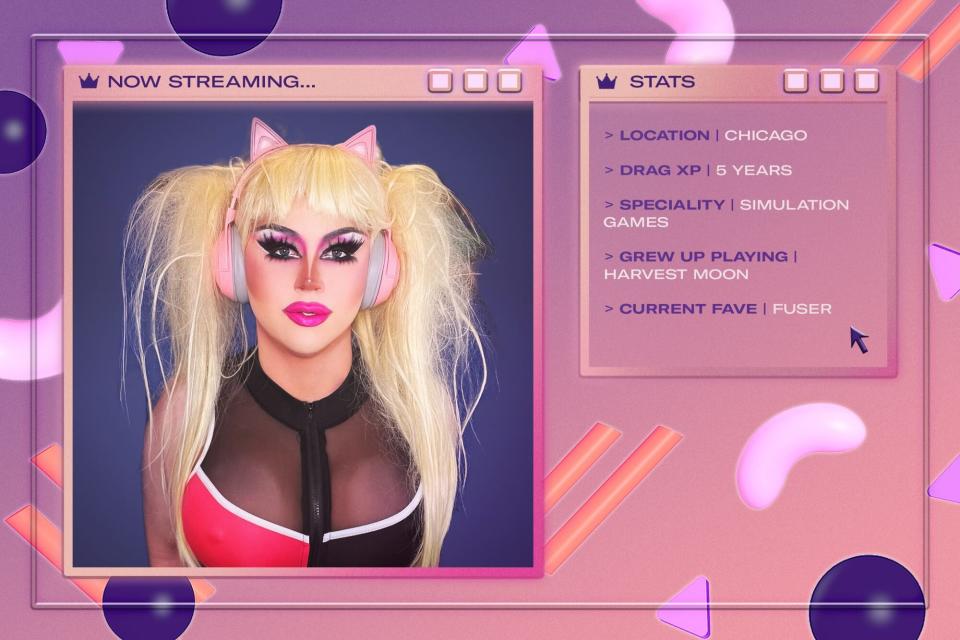
Illustrators: Sarah Maiden and Emily Lundin, Drag Trashly, HelloGiggles
HG: How did you get involved with Stream Queens, and what has it meant to you to be a part of this community?
Drag Trashly (DT): I've been with Stream Queens from the very start. When I first started streaming on Twitch in the fall of 2016, I thought I was the only drag queen on the platform but eventually Deere and I found each other. After a while, more drag artists began streaming and, though not official, we formed a small drag community. We met up at Twitch cons and drag cons, and I was so happy to find a community of drag artists I felt like I belonged to and could effortlessly connect with. RuPaul always discusses the importance of finding your community, and I never really understood what that meant until I met my Stream Queen siblings. I'm so fortunate to be a part of a group of such amazing and creative artists who are also some of my best friends.
HG: What are your hopes for the drag streaming community as it continues to grow?
DT: Most of the drag we know and see today comes from Black and Brown transgender and gender non-forming ballroom, voguing, and drag performers. But we don't see that represented in the Twitch drag community. It's important to showcase the small representation that is here so others can see themselves being represented and feel like they belong. Also, it's expensive to get started streaming and that makes it at least 10 times as hard for non-white drag artists because of systemic racism and inequality. The more we amplify diverse voices, the more they are seen, heard, and hopefully paid.
HG: How do you think drag and E-girl looks play off of one another in the streaming world?
DT: Exaggerated cut creases, thick brows, overdrawn lips were all inspired from drag, but honestly, I think recently a lot of the E-girl community makeup has been inspiring drag trends. I'm seeing a lot of graphic eyeliner, blushy noses, drawn on freckles, bandaids on the face. I've even recently seen drawn on eyebags (thankfully, I was naturally blessed with those).
Drag, to me, is playing around with gender expression and exaggerating society's expectations of beauty. So really, as minor as it may be, we are always dragging ourselves up in a way, whether it's as simple as dying your hair blue or as extreme as covering your face in an inch of makeup and throwing on a wig the size of a Land Rover.
HG: How do you cope with internet trolls? And do you have any advice for others who are experiencing hate online?
DT: It's so disheartening that there is still so much hate toward members of the LGBTQIA+ community, especially in the gaming world. I am so fortunate to have a group of amazing moderators on Twitch streams to protect me from a lot of what I might see and experience with trolls. Just having someone in your chat who's on your side and there to shut down any trolls feels amazing. I'm always tempted to respond to trolls by being sassy or reading them to filth. Don't waste your breath. Once you realize their only goal is to get a response from you, ignoring them is a much more powerful tool. Or do what I learned from Deere—just mispronounce and misunderstand their messages until they get banned or leave in frustration.
Erika Klash
@erikaklash | The Boulet Brothers' Dragula S2 Contestant
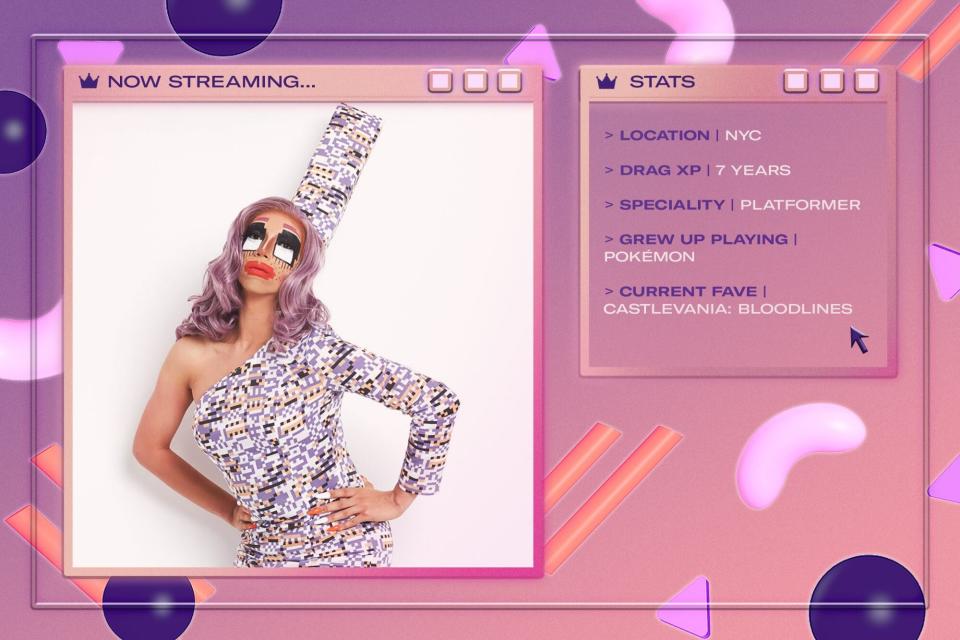
Illustrators: Sarah Maiden and Emily Lundin, Erika Klash, HelloGiggles
HG: When did you first get involved with streaming?
Erika Klash (EK): This past January! I first had the idea when performing at a Pride event at San Francisco's Twitch HQ in 2019. I spent a lot of 2020 preparing for this undertaking—but in 2021, I finally felt ready to launch my channel.
HG: How do you think drag, E-girl and cosplayer communities relate to one another?
EK: I've always felt that there's been a relationship between cosplay and drag. And I would say that, like cosplayers and drag artists, E-girls are expressing a character to some degree. There's overlap between all three. The cultural traditions that bore and shaped them are what makes each of these forms unique and defines them today. Cosplayers come out of the convention world, E-girls came out of this edgy online space, and historically, it has been those physical queer spaces (bars, clubs, etc.) where drag culture has really flourished.
HG: How do these drag, E-girl, and cosplayer communities create a safe space for queer representation and acceptance?
EK: Since appearing on Season 2 of Dragula, I have always maintained that nerds have often been marginalized within queer spaces. In larger society, the feeling of being a social "other" as a queer person can be compounded upon by being a nerd. That's why it has been important for us as drag streamers to carve out a space for ourselves in a platform that appears to be relatively male and relatively straight, and that allows us to monetize our art in a new way. That helps us envision a queer entertainment industry that isn't only about drag bar sales or which Drag Race/Dragula artist is coming to town.
HG: How does your drag aesthetic differ from others? Do you see it translating into gamer makeup looks?
EK: I don't particularly follow makeup trends. I know of the popular makeup brands that other drag artists use, but I tend to think of my makeup as character makeup as opposed to strictly "beauty" makeup, so I don't typically buy from those brands. There are essential elements of drag makeup that carry over, like contouring and highlighting, but I tend to draw on an entirely new face that expresses Erika Klash as this specific cartoon character. If I had to take a guess, perhaps folks in the E-girl community may take a page out of the edgier Dragula aesthetic and play with looks featuring contact lenses, longer nails, and studded chokers.
Read more stories in The Game Plan here.

